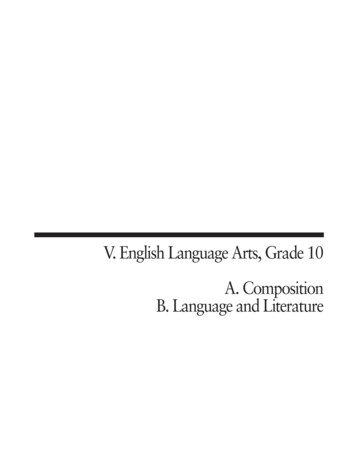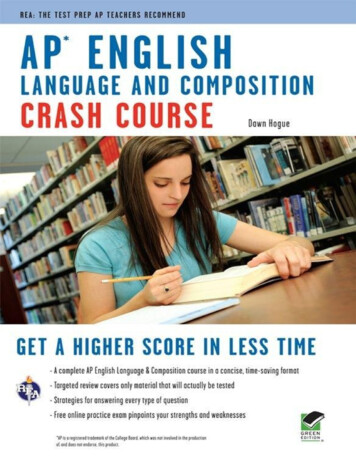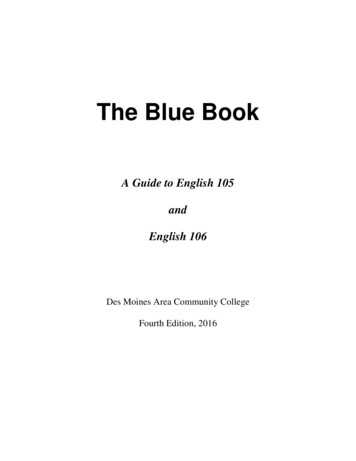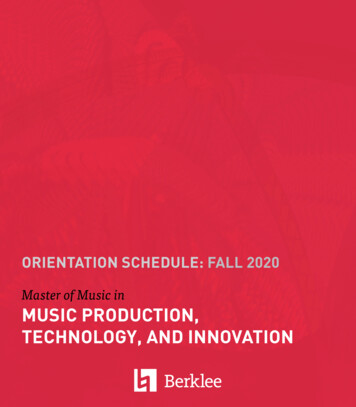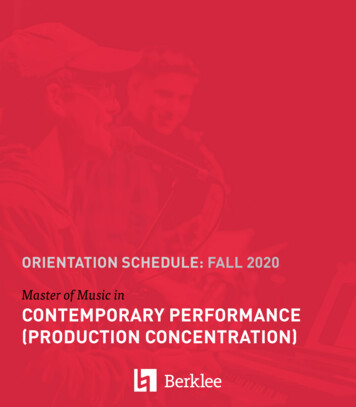
Transcription
Study GuideEnglish Composition
1LESSON ASSIGNMENTS19LESSON 1: CRITICAL THINKING, READINGAND WRITING SKILLS23LESSON 2: THE READINGAND WRITING PROCESS47LESSON 3: REVISING AND EDITING67LESSON 4: NARRATION AND PROCESS ANALYSIS85LESSON 5: CLASSIFICATION AND DIVISION119LESSON 6: RESEARCH AND MLA CITATION155LESSON 7: ARGUMENTS169SELF-CHECK ANSWERS193ContentsINSTRUCTIONS TO STUDENTSiii
Welcome to English Composition. You may be surprisedto find out that, even now, you’re already a writer. You’veprobably done a great deal of writing as a student and perhaps in other roles, as well. Maybe you’ve kept a diary, triedyour hand at poetry, or written a short story. Maybe youhave a job or a voluntary position that requires records,reports, or case notes. Even if you’ve never thought ofsuch activities as writing experience, they are.This course is designed not to make you a writer fromscratch but to encourage your growth as one. Both thetextbook and the instructors will guide you in developingthe skills and techniques of effective writing through practice.You’ll learn to make conscious decisions using particulartools to communicate more effectively and efficiently toyour reader.COURSE OBJECTIVESYou’ll learn to apply different writing strategies in varyingarrangements to explore, develop, and refine written workaccording to your purpose and audience.When you complete this course, you’ll be able tonnnnnnnnIdentify the steps in the writing processUse prewriting, drafting, revising, and editing to writeformal, college-level essaysDistinguish between different patterns of developmentApply an appropriate pattern of development to a specificpurpose and audienceWrite effective thesis statementsWrite effective introductions and conclusionsDevelop paragraphs using topic sentences, adequatedetail, supporting evidence, and transitionsDefine plagiarism and academic honestyInstructionsINTRODUCTION1
nnnnEmploy responsible research methods to locate appropriate secondary sourcesQuote, paraphrase, and summarize secondary sourcematerial correctly and appropriatelyUse Modern Language Association (MLA) citation anddocumentation style to reference secondary sourcematerial correctly and appropriatelyApply the conventions of standard written AmericanEnglish to produce correct, well-written essaysCOURSE MATERIALSThis course includes the following materials:1. This study guide, which serves as a companion to yourtextbook, contains an introduction to your course andnnA list of lessons and reading assignmentsExercises and self-check quizzes to help you learnthe course content, and then synthesize and applyyour knowledge to journal entries and essays2. Your course textbook, Successful College Writing, whichcontains the assigned reading materialYOUR TEXTBOOKYour primary text for this course is Successful College Writing,Sixth Edition, by Kathleen T. McWhorter. Begin reviewing thetext by reading the table of contents on page xxvii–xlv. Thenfollow the study guide for directions on required readingassignments. Note the following features of your text:n2The “Writing Quick Start” features at the beginning ofeach chapter are short introductions designed to helpyou get a head start on the material. Make sure youwork through the exercises, even though they won’tbe formally evaluated.Instructions to Students
nnnThe major headings and subheadings break down eachchapter’s content into manageable sections. Exercisesand model essays are also important parts of everychapter.Modern Language Association and AmericanPsychological Association style guides for citing anddocumenting your research. These can be foundbeginning on page 616 in Chapter 24.The grammar handbook includes information andexercises on the foundational elements of writing, suchas grammar, sentence structure, punctuation, andword choice.ACADEMIC SUPPORT ANDONLINE RESOURCESPenn Foster’s digital library offers students access to onlineresources in all major disciplines and courses offered at PennFoster, as well as one of the most comprehensive academicdatabases available today, Expanded Academic ASAP.Penn Foster’s librarian is available to answer questions aboutresearch and to help students locate resources. You can findthe librarian in the Community, by using the Contact anInstructor link in the Help Center in your student portal,and the Ask a Librarian link in the library.Grammar ResourcesGrammarly.com is offering discounts to Penn Foster studentswho register for a year of service. For a discounted fee, PennFoster students have unlimited access to the Grammarly’sgrammar, spelling, and punctuation check, as well as theplagiarism check. For students who have limited experiencewith research writing, Grammarly could be the helping handyou need to negotiate the research papers in your future.To learn more about Grammarly or to register for an account,please contact an English instructor.Instructions to Students3
Other online resources for grammar, punctuation, sentencestructure, and mechanics include the following:Daily Grammar: http://www.dailygrammar.com/archive.shtmlBlue Book of Grammar and Mechanics: http://www.grammarbook.com/Guide to Grammar and Writing, sponsored by Capital Community College index2.htmPurdue University’s Online Writing Lab: http://owl.english.purdue.edu/owl/A STUDY PLANRead this study guide carefully, and think of it as a blueprintfor your course. Using the following procedures should helpyou receive maximum benefit from your studies:1. Read the lesson in the study guide to introduce you toconcepts that are discussed in the textbook. The lessonemphasizes the important material and provides additional tips or examples.2. Note the pages for each reading assignment. Read theassignment to get a general idea of its content. Then,study the assignment. Pay attention to all details, especially the main concepts.3. To review the material, answer the questions and problems provided in the self-checks in the study guide.4. Complete each assignment in this way. If you miss anyquestions, review the pages of the textbook coveringthose questions. The self-checks are designed to allowyou to evaluate your understanding of the material andreveal weak points that you need to review. Don’t submitself-check answers for grading.5. After you’ve completed and corrected the self-checks forLesson 1, complete the first exam.6. Follow this procedure for all seven lessons.4Instructions to Students
Note: Future lessons will include completing prewriting and essayexaminations, submitting journal entries, and attending webinars.COURSE INFORMATIONStudy PaceYou have a study time limit for the semester, but not one specificto English Composition. You must pace yourself wisely through thesemester’s courses. Allow sufficient time for reading, prewriting,drafting, revising, and grading. To learn more about study time andwhen to complete each assignment, see the ENG100 FAQ supplementon your student portal.Because the course goal is to help you grow as a writer, you’ll use theprocess approach to writing to identify your strengths and improveweaknesses. The prewriting assignments for Lessons 4 and 5 will helpyou to develop and organize your ideas, and must be evaluated beforeyour essays for those Lessons will be accepted. If you have othercourses available for study, you may work on those and submit thoseexams while also working to complete this English course.Course JournalYour course journal is an ongoing assignment that will be evaluated atregular intervals during the course. Instructions for the course journalare at the end of this introduction.Required WebinarsWebinars are live classes that students attend online. There are tworequired webinars in English Composition: “The Writing Process” and“Research Writing and Citation and Documentation.” The EnglishComposition course information includes webinar instructions and thewebinar schedule. Read the webinar instructions to learn how to register for a webinar. Webinar classes are offered at a variety of times to fitstudents’ schedules. To earn a passing grade in the webinar, you mustlog in on time, participate actively, stay for the entire class, and focuson the presentation, not other applications on your computer. There isnothing to submit on your My Courses page.Instructions to Students5
Exam SubmissionsUse the following information for submitting your completedexams:1. Multiple-choice examinations (Lessons 1, 2, 3, and 6):You’ll submit your answers for these exams online.2. Written examinations (Lessons 4, 5, and 7): Essays mustbe typed, double-spaced, in Times New Roman 12 pt.font and left justification. Use 1-inch margins on allsides. Note that most word-processing programs are setat 1 inch by default. Indent the first line of each newparagraph by one tab (five spaces). Tabs are generally setby default as well. Each page must have a properly formatted header containing your name, student number,exam number, page number, mailing address, and emailaddress, as in the following example:Jane Doe23456789 25020200 Page 2987 Nice StreetMy Town, AZ 34567janedoe@yahoo.comName each document using a unique file name whichwill help you identify the file, such as this example:Process Analysis Johnson.Exams may be submitted in Rich Text Format or MSWord. Preview your document before you submit toensure that your formatting is correct. You should takecare to check that the document you’ve uploaded is theone containing your final work for evaluation.EvaluationEvaluation usually occurs within seven business days ofreceipt. Exams are scored according to the parameters ofthe exam assignment using the associated evaluation chartlocated in the study guide. Your instructors will apply thegrading criteria, ensuring all essays are evaluated in thesame way. They may also include feedback on both the essayand the evaluation chart. Evaluations are monitored by thedepartment chairs of both the General Education Department6Instructions to Students
and Exam Control Department to ensure accuracy andreliability. To read the instructor’s comments, click on theView Project button next to your grade for the exam, thendownload the Instructor Feedback File. Be sure to save theInstructor Feedback File to your computer since it’s availableon your student portal for just a brief time.RetakesYou’re required to complete all assigned work, including aretake for any first-time failing attempt. The evaluation of anyfirst-time failing exam for English Composition will include aRequired Retake form. That form must then be included withyour retake exam submission to ensure proper handling. Ifthe assigned work isn’t provided, submissions will be evaluated according to the criteria, but points will be deducted fornot following the instructions. Please review school policyabout retakes in the Student Handbook.PlagiarismCarefully review the academic policies outlined in yourStudent Handbook on your student portal. The first submission that departs from this policy earns a grade of 1 percent.If it’s a first-time submission, the student may retake theexam (see the retake policy in the Student Handbook). A second such submission on any subsequent exam results infailure of the English Composition course.Grammar and MechanicsThe focus of this course is to engage you in the writingprocess so you learn to make deliberate decisions aboutwhich writing strategies will best help you accomplish yourpurpose for your audience.Instructions to Students7
Essay assignments require you to apply standard conventions of American English, which include correct andappropriate grammar, diction, punctuation, capitalization,sentence structure, and spelling. The course provides variousrevision exercises throughout the self-checks and lessonexaminations so that you can apply these conventions duringthe editing and proofreading phases of your writing. For moreinformation on the fundamentals of writing, refer to theAcademic Support and Online Resources section.GRADINGSix Traits of Good Essay WritingYour writing assignments will be evaluated on six traits ofgood writing. The instructions for each exam include thegrading evaluation form, or rubric, that instructors will useto grade your work. It's important to review the rubric foreach exam before you submit to ensure that you have met allthe requirements.CriteriaIdeas and ContentThe essay’s content is clear, original, and pertains to theassigned subject. In addition, you should have a welldeveloped thesis that fits the topic, audience, and purposeof the assignment. There should be enough evidence (whichshouldn’t be from outside research unless that is part of theassignment) to help the reader understand the point you’remaking and to keep the reader’s interest.8Instructions to Students
Citation and DocumentationWhen you incorporate borrowed content from other sourcesinto your writing, you must cite and document your sourcesusing Modern Language (MLA) format. For more informationon MLA format, refer to Chapter 24 in your textbook.OrganizationAll essays need a clear beginning, middle, and end. Considereach paragraph as a mini-essay, containing a thesis that’srelated to the main purpose of the entire essay. Thinking thisway can help your essay retain unity and make sense. Usetransitional phrases to ease the movement and make connections between the paragraphs.VoiceUse the appropriate point of view for the style of essay youare writing: first person for personal narratives; third personfor critical essays.Word ChoiceDon’t use slang, jargon, Internet abbreviations, or profanity.Remember, these are college-level essays; they require formal,proper American English writing.Sentence FluencyMix your sentence styles. Readers dislike reading all short,choppy sentences or a series of long sentences.ConventionsRun a spell check and grammar check, and proofread theessay. In addition, ensure that you met the length and formatrequirements.Instructions to Students9
Skill LevelsAll these criteria are evaluated according to skill levels. Here’san explanation of the skill levels:Skill not evident. (69–0) If the essay scored in this category,the assignment either doesn’t include this required elementor severely lacks this trait.Skill emerging. (70–79) If the assignment scored in this category, the writing lacks the trait or is below average for acollege-level paper.Skills developing. (80–89) If the essay scored in this category, the essay shows effort and competence but indicates alack of complete understanding or command in this area.Skill realized. (90–100) If the assignment scored in thiscategory, the writing demonstrates that you’re in command ofthe skills.10Instructions to Students
Instructions to StudentsCourse RubricUse prewriting, drafting,revising, and editing towrite formal, college-levelessaysDistinguish betweendifferent patterns ofdevelopmentWrite effective thesisstatementsCourseObjectivesEmploy responsibleresearch methods tolocate appropriatesecondary sourcesUse Modern LanguageAssociation citation anddocumentation style toreference secondarysource material correctlyand appropriatelyDevelop paragraphs usingtopic sentences, adequatedetail, supportingevidence and transitionsQuote, paraphrase andsummarize secondarysource material correctlyand appropriatelyUse Modern LanguageAssociation citation anddocumentation style toreference secondarysource material correctlyand appropriatelyApply the conventions ofstandard written AmericanEnglish to producecorrect, well-writtenessaysApply the conventionsof standard writtenAmerican English toproduce correct, wellwritten essaysApply the conventionsof standard writtenAmerican English toproduce correct, wellwritten essays11
12GRADING CRITERIAIDEAS AND CONTENTThe essay provides aclear thesis statementthat effectively introducesthe topic and states aclaim.The thesis effectivelypreviews the main pointsof the essay.The essay presents ideasthat are fresh, insightfuland engaging.APaper100-90The essay providesspecific, relevant evidenceto illustrate ideas andsupport the thesis.The essay effectivelyemploys the required,and if necessary otherrelevant patterns ofdevelop to effectiveconvey ideas.Instructions to StudentsIdeas that cannot beconsidered commonknowledge are correctlycited and documentedusing Modern LanguageAssociation (MLA) citationformat.ORGANIZATIONIntroductory paragrapheffectively engages thereader and includes athesis statement whichstates both topic andclaim.The main ideas thatsupport the thesis areeffectively organized intoparagraphs beginningwith clearly defined,correct topic sentences.Evidence provided withineach paragraph clearlyand relates to the topicsentence and thesisstatement, effectivelysupporting the main ideaand purpose of theessay.Transitions are usedeffectively to guide thereader through the essay.The conclusion effectivelyreinforces the thesisstatement and provides asatisfactory ending to theessay.VOICEThe essay addresses theappropriate audience.The essay effectivelyengages the audiencewith appropriate toneand point of view.The essay is focusedon the writer’s ownclaim, knowledge andexperience.If secondary sources arepresent, they are usedcorrectly and effectivelyto support the writer’sown claims.The essay effectivelyaddresses the purpose ofthe assignment.CLARITY ANDCORRECTNESSLENGTH AND FORMATThe essay is free oferrors in sentencestructure, grammar,punctuation, and wordchoice.The essay meets thelength requirementaccording to thedirections in the digitalstudy guide.Unfamiliar and technicalterms are clearly andeffectively defined forthe reader.The essay is formattedusing the correct header,font and margins.The essay has beeneffectively proofread,edited and spell andgrammar-checked.
Instructions to StudentsGRADING CRITERIAIDEAS AND CONTENTORGANIZATIONVOICEThe essay provides athesis statement thatstates the topic althoughthe exact claim is notarticulated.The introduction identifiesthe topic and includes athesis statement butoffers little beyond theobvious to engage thereader.The essay adequatelyaddresses the appropriateaudience.The thesis offers adequatedirection for the essay,but does not explicitlyoutline main points.The essay offers adequateinsight and ideas, thoughmuch of the informationis factual or obvious.BPaper89-80Most paragraphs beginwith a topic sentence thatrelates to and supportsthe thesis statement.Most evidence providedis relevant to the topicsentence and thesis.The essay offers specificevidence to illustrateideas and support thethesis.The writer uses transitionsbetween most paragraphsto guide the readerthrough the essay.The writer follows therequired pattern ofdevelopment, andincorporates otherpatterns adequately todevelop content.The conclusion restatesthe thesis, but lacksdevelopment thatwould end the essaysatisfactorily.The writer has attemptedto use MLA format toindicate borrowedcontent but formattingrequires some revision.The essay adequatelyengages the audienceusing appropriate toneand point of view.The essay is adequatelyfocused on the writer’sown claim, knowledgeand experience.If secondary sources arepresent, they are usedcorrectly and effectivelyto support the writer’sown claims.The essay adequatelyaddresses the purpose ofthe assignment.CLARITY ANDCORRECTNESSThe essay is reasonablyfree of errors in sentencestructure, grammar,punctuation, and wordchoice.Unfamiliar and technicalterms are clearly andadequately defined forthe reader.The essay has beenproofread, edited andspell and grammarchecked but includesminor errors in wordchoice that would drawthe reader’s attentionaway from the purposeand content.LENGTH AND FORMATThe essay exceeds themaximum length for theassignment but contentis engaging and directlyrelated to the thesis andpurpose.The essay falls short ofthe minimum length forthe assignment, butcovers all requiredelements adequately.The essay is formattedusing the correct header,font and margins.13
14GRADING CRITERIAIDEAS AND CONTENTThe thesis is a factualstatement that offers noclaim or assertion.The thesis offers somedirection for the essay,but does not explicitlyoutline main points.Some fresh insight isprovided, though much ofthe information is factualor obvious.CPaper79-70The essay offers somespecific evidence toillustrate ideas andsupport the thesis.The writer follows therequired pattern ofdevelopment, but theessay lacks the contentthat additional patternswould provide.The writer has attemptedto use a citation anddocumentation format,but does not adequatelycredit secondary sources.ORGANIZATIONThe introduction includesa thesis statementbut is otherwiseunderdeveloped.The writer attempts toorganize main ideas intoparagraphs but topicsentences are weak anddo not control content;paragraphs lack focusand logical development.Evidence is provided butits relationship to thethesis and topic sentenceis not clearly defined.Some evidence is notrelevant to the thesis andtopic sentence.Transitions are used insome cases, but theessay lacks cohesivenessoverall.The conclusion restatesthe thesis statement, butis underdeveloped orcontains irrelevantinformation.VOICEThe essay illustratessome awareness ofaudience.The essay employscolloquial or idiomaticlanguage, lackingappropriate tone andpoint of view.The essay is somewhatfocused on the writer’sown knowledge andexperience but lacks aclear claim or position onthe topic.If secondary sourcesare present, they areidentified but citationand documentation isincorrect and requiresrevision.The essay addresses thepurpose of the assignment only tangentially.CLARITY ANDCORRECTNESSLENGTH AND FORMATThe essay is includeserrors in sentencestructure, grammar,punctuation, and wordchoice.The essay exceeds themaximum length forthe assignment; contentis repetitive andunengaging.Unfamiliar and technicalterms are somewhatdefined for the readerbut lack full development.The essay falls short ofthe minimum length forthe assignment, anddoes not fully addressthe topic and purpose.The essay showsattempts at proofreading, editing and spelland grammar-checking,but includes severalerrors in word choicethat would draw thereader’sattention away from thepurpose and content.The essay includes thecorrect information forthe header but it is notinserted correctly.The essay does notemploy the correctformatting.Instructions to Students
Instructions to StudentsGRADING CRITERIAIDEAS AND CONTENTThe essay does not offera thesis statement.The ideas presented arenot original to the writer;ideas do not conveywriter’s engagement withtopic.The essay does notprovide specific, relevantevidence to illustrateideas and support thethesis.FPaper69-0The essay does notemploy the required orrelevant patterns ofdevelop to effectiveconvey ideas.Ideas that cannot beconsidered commonknowledge are not citedand documented.ORGANIZATIONIntroductory paragraphdoes not engage thereader, lacks thesisstatement anddevelopment.Essay lacks clearlydefined main ideas; theessay is not organizedinto paragraphs.Essay lacks evidence orprovides unreliable orinaccurate.The essay lackstransitional words,phrases or sentences.The essay lacks aconclusion, or theconclusion containsirrelevant information.VOICEThe essay does notaddress the appropriateaudience.The essay does notengage the audiencewith appropriate toneand point of view.The essay relies heavilyon secondary sourceswith little to no focuson the writer’s claim,knowledge, andexperience.If secondary sources arenot cited or identified,resulting in plagiarism.The essay does notaddress the purpose ofthe assignment.CLARITY ANDCORRECTNESSThe essay containsnumerous errors insentence structure,grammar, punctuationand word choice, making it difficult for areader to follow andcomprehend.No attempt is made todefine or clarify unfamiliarterms.The essay does notappear to have beenproofread, edited orspell and grammarchecked.LENGTH AND FORMATThe essay does notmeet the length requirements.The font, margin and linespacing do not meet therequirements.The header is missing.15
Course JournalYour course journal isn’t just a series of examinations, it’s also a record of your progress throughEnglish Composition. As you complete the 18 journal entries, you’ll have the opportunity to testthe stages of the writing process, practice different methods of organizing your essays, and evaluate your progress in the course. All the journal entries are included in your study guide; eachentry corresponds to the assigned reading in your textbooks.The journal serves as the final exam. Remember the following objectives as you work oneach journal:n Identify the steps in the writing process.n Use prewriting, drafting, revising, and editing to write formal, college-level essays.n Distinguish between different patterns of development.n Apply an appropriate pattern of development to a specific purpose and audience.n Write effective thesis statements.n Develop paragraphs using topic sentences, adequate detail, supporting evidence,and transitions.n Define plagiarism and academic honesty.n Employ responsible research methods to locate appropriate secondary sources.n Quote, paraphrase, and summarize secondary source material correctly and appropriately.n Use Modern Language Association citation and documentation style to reference secondarysource material correctly and appropriately.n Apply the conventions of standard written American English to produce correct,well-written essays.Directions: Read each entry assignment carefully. Some entries are based on textbook exercises forwhich the pages are given. Most entries require multiple parts to be considered complete. For example, you might have to complete both a prewriting and a thesis. Assignments generally include aminimum length, a range, or a general format (such as one paragraph). A few assignments allow youto choose the length and format to accomplish the required work. The guidelines list the minimumamount of work you must produce, but you should continue writing until you complete your thoughtsand demonstrate your knowledge and ability to apply the relevant concepts. Complete each journalentry as you read the corresponding assignments in your textbook and study guide. You'll use yourtime more efficiently.16Instructions to Students
The course journal is divided into three parts made up of six entries each. At the end of eachcourse unit, you’ll submit your journal for evaluation. Therefore, you’ll submit your journalsn After you complete Lesson 3n After you complete Lesson 5n After you complete your argument essayFormat: Use the exam submission instructions already given, except that you should single-spaceyour journal. Use double spacing between entries only. First, type the date, hit Tab once (onehalf inch), and type in capital boldface letters the word ENTRY, followed by the number and nameof that entry. Hit Enter once, and then type in and underline the first part label followed by yourwriting for that part. Then, do the same for any additional parts. Use this example as a guide:May 1, 20—ENTRY 1: Me, A Writer?Attitude: I enjoy writing, but I hate being graded . . .Inventory: I am a social learner, so a distance education approach may be difficult for me . . .May 20, 20—ENTRY 2: The Role of Correctness in WritingEvaluation: Your journal will be evaluated according to the same requirements used for all writtenassignments requirements:n Ideas and content—How accurately and effectively you’ve responded to the entry. Yourwriting is focused on the topic of the entry and is based on the correct reading assignmentsin your texts; you’ve effectively engaged with the content of the reading assignments andcomposed thoughtful original responses to each entry; when required, you cited anddocumented secondary source material appropriately and correctly.n Organization—How well each entry is developed. All paragraphs begin with an appropriatetopic sentence and are developed fully by using examples, illustration, and/or evidence;each entry meets the required minimum length.n General correctness—How well entries meet the expectations of college-level academicwriting in the following areas:n Sentence structuren Grammarn Word choice and spellingn Punctuationn Format—How accurately you’ve followed the prescribed format for the journal byincluding the required header, entry title and date, and used correct margins, font,and line spacing.Instructions to Students17
NOTES18Instructions to Students
Lesson 1: Critical Thinking, Reading and Writing SkillsFor:Read in thestudy guide:Read in thetextbook:Assignment 1Pages 24–27Chapter 1Assignment 3Pages 32–39Part 7, Pages 721–779Assignment 2Assignment 4Assignment 5Pages 28–31Chapter 2Pages 40–43Pages 44–46Examination 250394RRChapter 3Chapter 4Material in Lesson 1Lesson 2: The Reading and Writing ProcessFor:Read in thestudy guide:Read in thetextbook:Assignment 6Pages 47–52Chapter 5Assignment 8Pages 57–61Chapter 7Assignment 7Assignment 9Pages 53–56Pages 62–65Examination 250395RRChapter 6Chapter 8Material in Lesson 2Lesson 3: Revising and EditingFor:Assignment 10Assignment 11Read in thestudy guide:Pages 68–74Pages 75–80Examination 250396RRRead in thetextbook:Chapter 9Chapter 10Material in Lesson 3Unit 1 Course Journal: Entries 1–6 25020000AssignmentsUnit 1: Introduction to Composition19
Unit 2: The Writing Process in ActionLesson 4: Narration and Process AnalysisFor:Assignment 12Assignment 13Assignment 14Assignment 15Assignment 16Read in thestudy guide:Read in thetextbook:Pages 90–94Chapter 12Pages 85–89Pages 95–99Pages 100–103Pages 104–107Chapter 11Chapter 13Chapter 14Chapter 15Examination 25020100 Prewriting: Process AnalysisExamination 25020200 Essay: Process AnalysisLesson 5: Classification and DivisionFor:Assignment 17Assignment 18Assignment 19Assignment 20Read in thestudy guide:Read in thetextbook:Pages 126–130Chapter 17Pages 120–125Pages 131–135Pages 136–140Chapter 16Chapter 18Chapter 19Examination 25020300 Prewriting: Classification and DivisionEx
English to produce correct, well-written essays COURSE MATERIALS This course includes the following materials: 1. This study guide, which serves as a companion to your textbook, contains an introduction to your course and n A list of lessons and reading assignm

